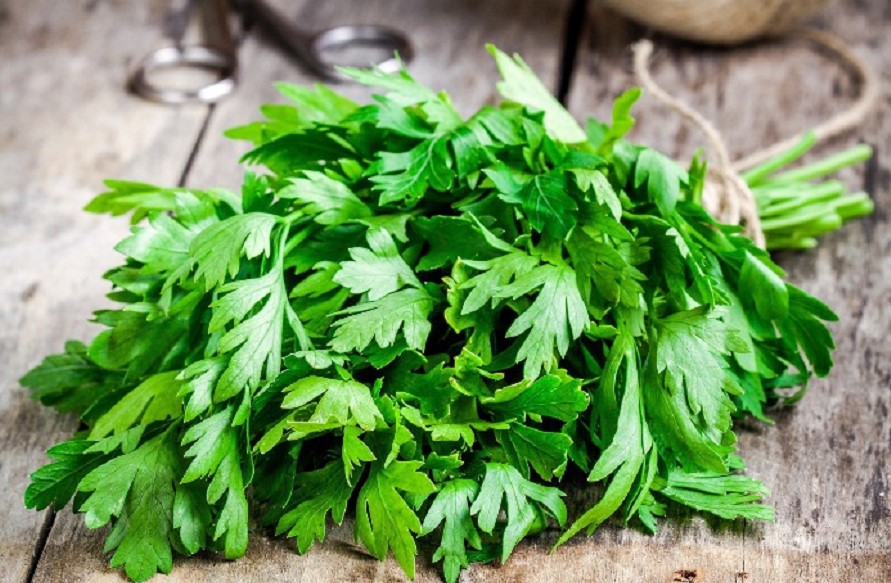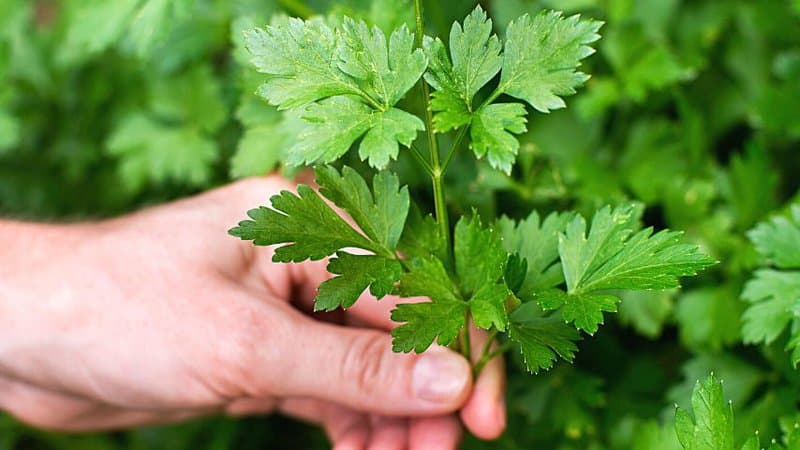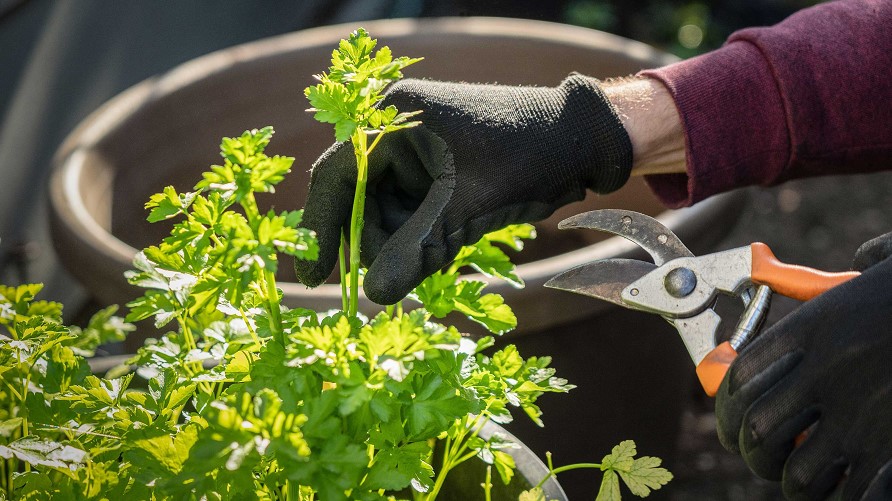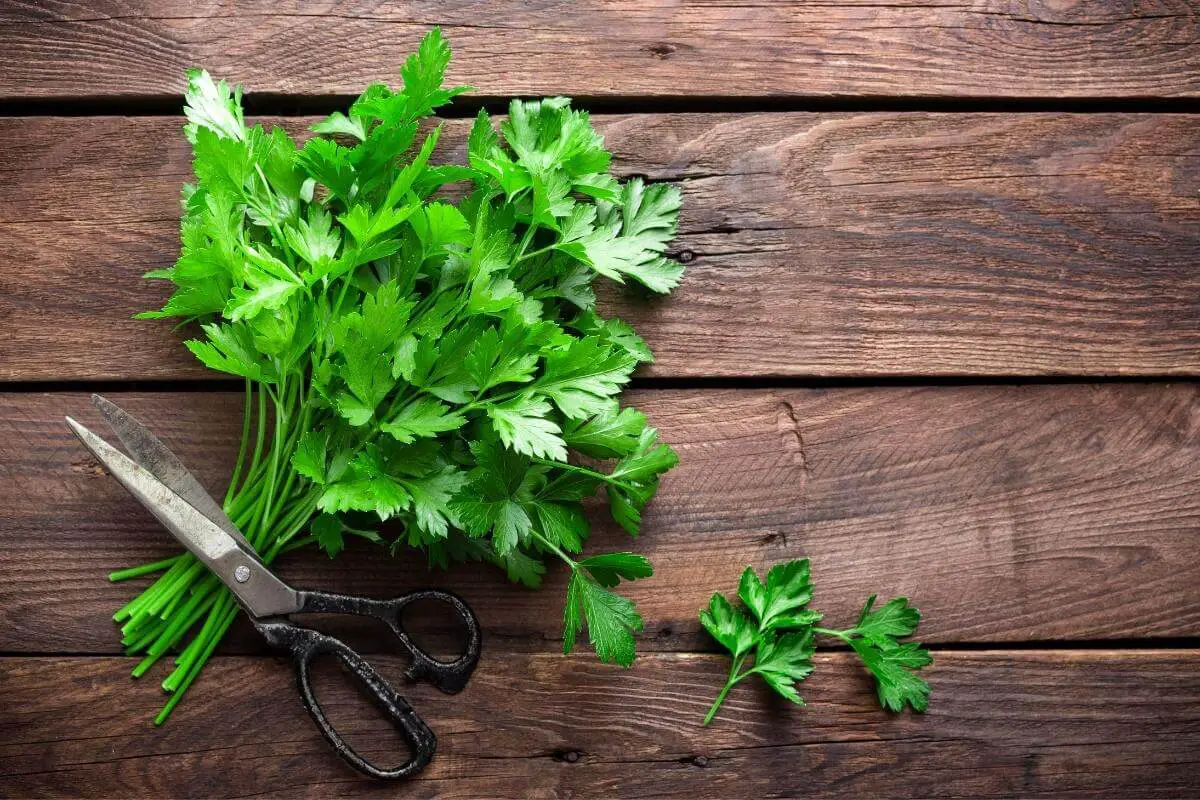Parsley is an extremely popular plant that you can find in almost each herb garden. It is leafy, fast-growing, and has a uniquely delicious flavor that makes it such a desired ingredient in many dishes.
Maintaining and pruning parsley is not difficult at all. However, pruning parsley plants requires some special tips to keep in mind.
Are you looking for easy hacks on how to prune parsley? Then, we are here to help you!

How to prune parsley plants?
For a caring gardener, pruning parsley is an easy routine task. The main point to keep in mind is that pruning parsley helps it to thrive.
Like with other herbs, pruning is an essential part of the parsley’s life cycle.
Don’t forget to prune your parsley regularly if you want to keep it in the best condition.
So, how to prune parsley plants and why do it?
Why you should prune parsley regularly:
- Promote more growth
- Encourage more foliage
- Keep the parsley plant healthy
- Prevent overgrowing and overcrowding
- Access to more sunlight
- Prevent pests and diseases attacks
- Keep it looking tidy
- Prevent the formation of flower buds
- Increase parsley yields
- Improve flavor and texture
Parsley is one of the easiest herbs to grow and maintain. You don’t need to do much for it. However, there are some easy but essential points on how to prune parsley plants.

#1. Know the right time to harvest your parsley
Although parsley is technically a biennial plant, it is better to harvest your parsley during its first year of life.
When flowering occurs in the second year, the leaves start tasting worse and get bitterness. So, the best idea is to harvest your parsley as an annual plant, when the leaves still taste good.
As soon as you are ready to harvest parsley, prune your parsley immediately! Since parsley grows so fast, you need to prune it multiple times during the whole growing season.
Although you already know that you should treat parsley as an annual plant, there is a point to keep in mind.
Unlike most annual plants that you harvest and cut back once, parsley is good for multiple harvesting all growing season long.

#2. Inspect your plant before pruning
Don’t start pruning parsley until you inspect the entire plant well and evaluate the whole plant’s condition.
Look at the whole plant and note its peculiarities. Pay the most attention to the structure and shape of your plant to know better where to prune first.
Look for the signs of new growth.
In case some new growth signs are being blocked, the best idea is to start pruning from these areas.
Search for the long stems growing out of the plant edges. These long outer stems are already mature and ready for harvesting. Besides, long stems can block out new stems and leaves growth.
Dispose of the yellow leaves and stems on your parsley plant. Cut the dead and dying leaves off the stems to keep the plant healthy.
As soon as you find an unhealthy part of your plant, cut the entire stem down at the base of it. It is also okay to pinch the yellow leaves away from the plant.

#3. Use clean and sharp pruning shears
A clean and smooth cut is also essential when pruning parsley. Since this plant requires frequent pruning, you need to do it with perfect pruning shears.
Although many gardeners find it okay to prune with regular kitchen shears, it is not the best idea though.
Kitchen scissors may be not sharp enough to deal with wider parsley stems.
Using the wrong shears can cause tears and wounds that often lead to infections and pest infestations. Torn and injured stems are vulnerable to many diseases and make lots of risks for the plants.
Always prune your parsley with a sharp pair of pruning shears. They will help you to remove stems smoothly.
Choose the pruning shears that you are going to use for pruning parsley. Sharpen them regularly to keep them in the best condition. Before pruning, make sure that your shears are sharp enough.
Use only clean pruning shears! Wash the pruning tool before using it and wipe it with a piece of clean cloth.

#4. Smart pruning hacks
Don’t forget that parsley is one of the fastest-growing herbs. So, you need to prune it every 2-3 weeks to keep it in tip-top shape.
Cut the base of each growing stem. Try to make cuts at a 45-degree angle if possible. Keep in mind that your cut should point in the opposite direction of any plant’s buds. However, why do you need to follow this cutting method?
Since you cut the stems and leaves this way, it helps you to protect your plant when watering. Angled cuts direct water away from the new growing buds.
Thus, you can’t damage new parsley leaves and stems while watering.
Remember that you can only prune stems with three or more segments or leaves. It helps the plant to grow healthily. You can’t prune stems that don’t have an adequate number of leaves.
Snip off the lower parsley leaves that already start to turn yellow. It helps you to boost the growth of the new stems.
When growing parsley, a good rule of thumb is to encourage and maintain the new growth in the central part of the plant by snipping off the outer stem. Since both Italian and curly parsley grow similarly, you can prune and maintain them with the same methods.
Pinch away the yellowing leaves as they don’t have the freshest flavor anymore. Pick fresh and green foliage. Fresh leaves have the best flavor which makes them perfect for adding to your dishes.
Never cut all the stems back on your plant at the same time. You can stunt the plant’s development and prevent it from regrowing.

#5. Deal with flowering
Flowering tips are important when learning how to grow parsley. When you grow parsley for two seasons, you will get flowers in the second year.
During the first year, your plant doesn’t produce seeds. However, flowering means some definite problems for you.
After flowering, leaves usually turn bitter, so they are no more edible. To prevent your parsley from flowering too early, don’t forget to prune it just in time.
Remove the flower stalk with a pair of sharp and clean scissors. For the next year, leave the flowers and let them produce seeds.
Never ignore removing the dead flowers from the plant. Like any dead matter, they should be cut down. Even after they are spent, flowers still absorb energy from the plant.
You can just pinch the dead flower buds without using shears. This process is also known as deadheading.
#6. After-pruning tips
A good rule of thumb is to fertilize the soil after pruning. Since parsley keeps the vital nutrients in its foliage, there is a partial loss of them when pruning. That’s why you need to replenish your plants with extra nutrients by fertilizing the soil after you prune the plant.
Make sure you add just a small amount of fertilizer. Remember that adding too much fertilizer is harmful to plants.
Don’t fertilize plants that you have already fed recently.
For having tasty and fresh parsley all year round, keep the pruning schedule. It will be easier for you to keep both pruning and fertilizing schedule to grow healthy plants.
After pruning, you can dry parsley or use it fresh as well.

FAQ
Should parsley be cut back?
Trimming is an essential part of growing parsley plants. There are several reasons why you should cut back the parsley plant regularly.
When you cut parsley back for cold seasons, it helps the plant to survive better during winter. After cutting back, add about 2 to 3 inches (or 5-8 cm.) of mulch around the parsley plant to cover it as well.
Routine trimming helps your parsley plants to regrow more vigorously.
How often should you prune parsley?
Regular pruning is crucial for keeping the parsley plant healthy. Since the parsley plant is fast-growing, you need to prune it regularly. For the pruned plant, it takes two to three weeks to fully regrow.
Remember that overgrown segments create a hot and humid environment that means a breeding ground for fungal pathogens.
Why is my parsley getting leggy?
Lack of sunlight is the main reason for a leggy parsley plant. If there is not enough sunlight in your kitchen garden, then your plants start growing tall and leggy to reach more light.
As soon as you notice that your parsley plants are growing too tall and leggy, add some more grow light and prune regularly.
Conclusion
We hope that all the tips above will be helpful for you. Don’t forget to prune regularly for keeping your plants healthy!


